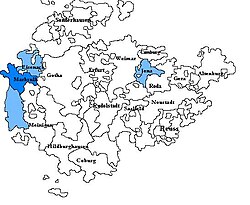This article needs additional citations for verification .(April 2017) |
Duchy of Saxe-Marksuhl Herzogtum Sachsen-Marksuhl | |||||||||
|---|---|---|---|---|---|---|---|---|---|
| 1662–1671 | |||||||||
 | |||||||||
| Status | State of the Holy Roman Empire | ||||||||
| Capital | Marksuhl | ||||||||
| Government | Principality | ||||||||
| Historical era | Middle Ages | ||||||||
• Partitioned from Saxe-Weimar | 1662 1662 | ||||||||
• Incorporated into Saxe-Eisenach | 1671 1671 | ||||||||
| |||||||||
The Duchy of Saxe-Marksuhl was one of the Saxon Duchies held by the Ernestine line of the Wettin Dynasty. Established in 1662 for John George I, third son of Wilhelm, Duke of Saxe-Weimar. Originally John George was supposed to share Saxe-Eisenach with his older brother, Adolf William. [1] Johann Georg finally accepted the receipt of an income from the duchy of Saxe-Eisenach and made his residence in the small town of Marksuhl. Saxe-Marksuhl was reincorporated into Saxe-Eisenach on the accession of John George to the Duchy of Saxe-Eisenach upon his nephew's death in 1671.[ citation needed ]
